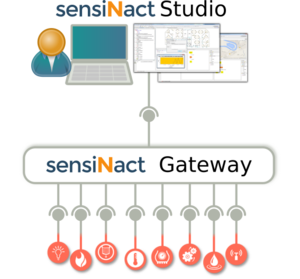Notice: this Wiki will be going read only early in 2024 and edits will no longer be possible. Please see: https://gitlab.eclipse.org/eclipsefdn/helpdesk/-/wikis/Wiki-shutdown-plan for the plan.
Difference between revisions of "SensiNact"
| (2 intermediate revisions by 2 users not shown) | |||
| Line 7: | Line 7: | ||
| product = sensinact | | product = sensinact | ||
}} | }} | ||
| + | |||
| + | [[Category:sensiNact]] | ||
| + | |||
| + | == WARNING == | ||
| + | |||
| + | This documentation wiki is out of date, please look at https://eclipse-sensinact.readthedocs.io/ for the latest version. | ||
| + | |||
| + | ---- | ||
'''Eclipse sensiNact''' (lower-case on the first '''s''' and capital letter on the second '''N''') aims at creating a common environment in which heterogeneous devices can exchange information and interact among each other in the IoT world. | '''Eclipse sensiNact''' (lower-case on the first '''s''' and capital letter on the second '''N''') aims at creating a common environment in which heterogeneous devices can exchange information and interact among each other in the IoT world. | ||
| Line 35: | Line 43: | ||
* [[SensiNact/endpoint-connector|Endpoint connector]] | * [[SensiNact/endpoint-connector|Endpoint connector]] | ||
* [[SensiNact/gateway-felix-configuration|HTTPS Felix Configuration]] | * [[SensiNact/gateway-felix-configuration|HTTPS Felix Configuration]] | ||
| + | * [[SensiNact/gateway-remote|SensiNact Remote]] | ||
== sensiNact gateway internals == | == sensiNact gateway internals == | ||
Latest revision as of 11:08, 23 February 2024
| Eclipse sensiNact | |
| Website | |
| Download | |
| Community | |
| Mailing List • Forums • IRC • mattermost | |
| Issues | |
| Open • Help Wanted • Bug Day | |
| Contribute | |
| Browse Source |
Contents
WARNING
This documentation wiki is out of date, please look at https://eclipse-sensinact.readthedocs.io/ for the latest version.
Eclipse sensiNact (lower-case on the first s and capital letter on the second N) aims at creating a common environment in which heterogeneous devices can exchange information and interact among each other in the IoT world.
Eclipse sensiNact is composed of two tools, sensiNact Gateway aiming at integrating devices and aggregating data from various sources and sensiNact Studio aiming at interacting with the sensiNact Gateway to visualize the devices and the data.
sensiNact is a horizontal platform dedicated to IoT and in particularly used in various smart city and smart home applications. sensiNact aims at managing IoT protocols and devices heterogeneity and provides synchronous (on demand) and asynchronous (periodic or event based) access to data/actions of IoT devices, as well as access to historic data with generic and easy-to-use API. To achieve these objectives, sensiNact comes with two complementary frameworks:
- sensiNact Gateway interconnects IoT devices using different southbound IoT protocols such as Zigbee, EnOcean, LoRa, XBee, MQTT, XMPP, as well as platforms such as FIWARE and allows access to them with various northbound protocols such as HTTP REST, MQTT, XMPP, JSON RPC and CDMI. The gateway can also host applications and manage them using an application manager module.
- sensiNact Studio proposes an IDE (Integrated Development Environment) based on Eclipse to manage the existing devices, in addition to develop, deploy and manage IoT applications.
Installation
Starting with sensiNact
Configuration
sensiNact gateway internals
Working with bridges
- Bridges introduction
- How to develop a southbound bridge (requires knowledge about Java, such as the architecture and the data model of sensiNact)
- How to create sensinact bridge local configuration
Development
Repositories
CI


